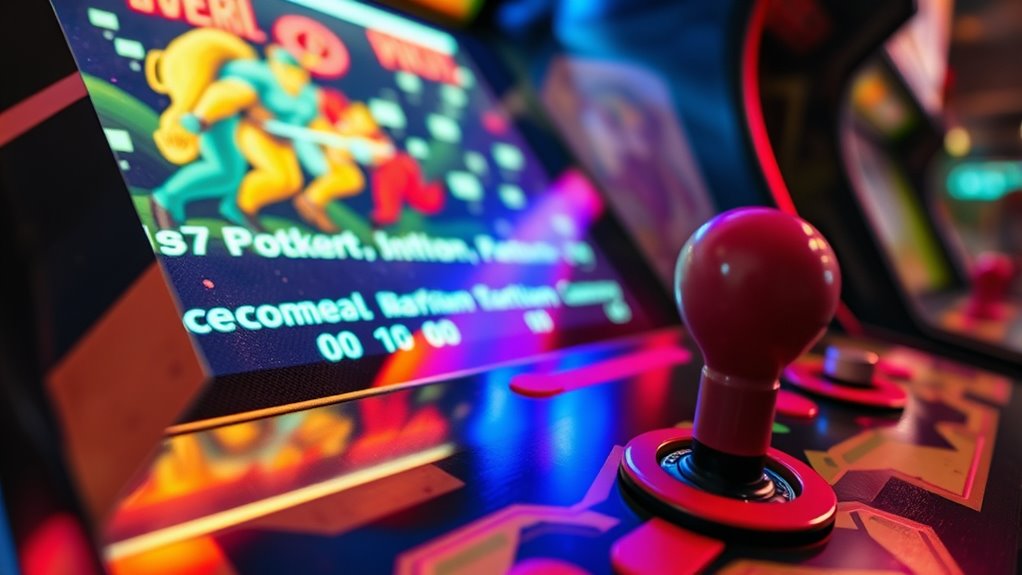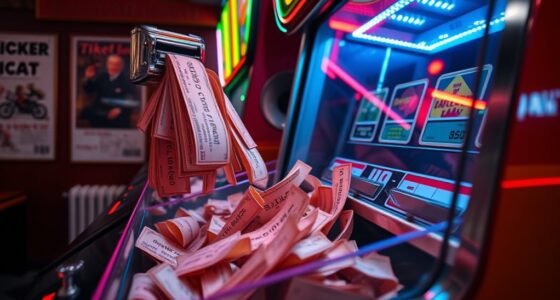Difficulty in coin-op game design balances challenge and fun, keeping players engaged and encouraging repeat plays. Early on, limited hardware pushed developers to focus on gameplay over graphics, experimenting with different ways to increase challenge. Proper difficulty motivates players, supports skill growth, and boosts replayability. It also influences revenue by encouraging in-game purchases and maintaining user interest. If you stay tuned, you’ll discover how designers craft challenges that foster mastery while appealing to all skill levels.
Key Takeaways
- Difficulty balances challenge and accessibility to motivate players without causing frustration.
- Adjusting difficulty levels and tutorials helps players learn mechanics and prevents early discouragement.
- Proper difficulty scaling enhances replayability by encouraging skill development and mastery.
- Creative difficulty adjustments, like enemy speed or progressive levels, maintain player engagement over time.
- Well-calibrated challenge impacts revenue by increasing retention and promoting in-game purchases.
The Evolution of Difficulty in Coin-Op Games
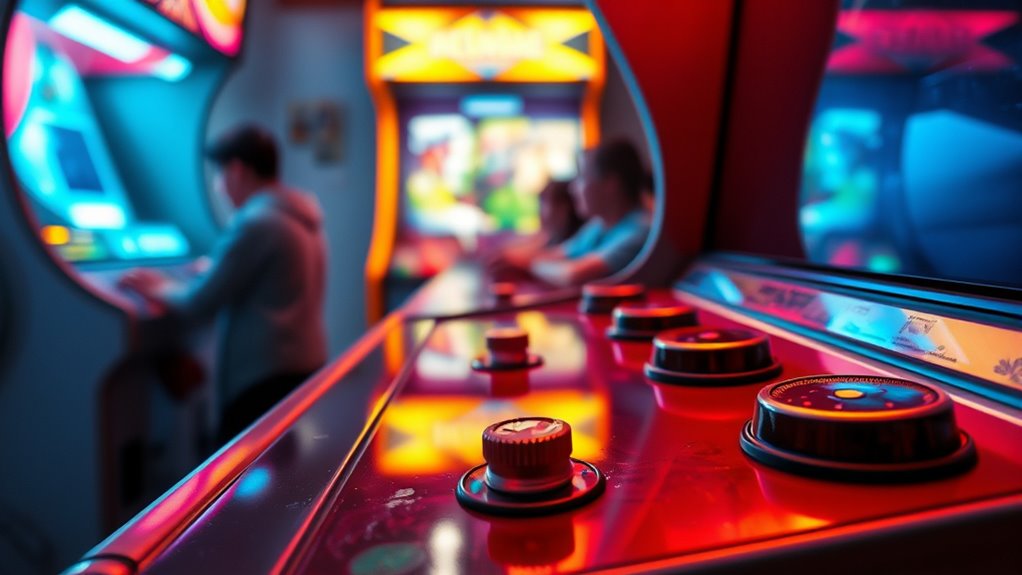
The evolution of difficulty in coin-op games reflects a constant balancing act between challenging players and encouraging continued play. Early arcade aesthetics favored simple, straightforward visuals that prioritized gameplay over graphics, partly due to hardware limitations. These limitations meant developers had to focus on making games engaging without overloading the hardware, which influenced difficulty levels. As technology advanced, game designers experimented with increasing challenge to keep players invested, yet they still aimed to avoid frustration. The hardware constraints pushed developers to find creative solutions, such as adjusting enemy speed or adding levels of difficulty, to maintain a balance. Incorporating sound design techniques, like dynamic audio cues, also helped signal difficulty changes and guide player behavior. This ongoing evolution shows how developers adapted to technological limits while endeavoring to craft engaging, challenging experiences that kept players coming back.
Balancing Challenge and Accessibility

As game designers push the boundaries of challenge to keep players engaged, they also face the task of making their games accessible to a broader audience. Balancing challenge and accessibility is key to maintaining player motivation without creating accessibility barriers. If a game is too difficult, newcomers may feel overwhelmed and give up; too easy, and players may become bored. To strike this balance, consider adjustable difficulty settings or intuitive tutorials that ease players into the experience. Clear visual cues and responsive controls help reduce frustration, making the game more welcoming. Incorporating user-friendly interfaces can further enhance accessibility by guiding players smoothly through the game mechanics. By thoughtfully designing for accessibility, you ensure that players of varying skill levels can enjoy the game while staying motivated to improve and succeed.
Difficulty as a Tool for Player Engagement

Difficulty serves as a powerful tool to heighten player engagement by creating a sense of challenge and accomplishment. When you encounter well-crafted difficulty, your motivation to succeed increases, pushing you to improve your skills. Effective difficulty scaling ensures that the game remains neither too easy nor too frustrating, maintaining your interest over time. As you progress, the game adjusts to your growing abilities, keeping you invested and enthusiastic to overcome obstacles. This continual balance sustains excitement and feeling of achievement, encouraging you to keep playing. By thoughtfully managing difficulty, designers tap into your desire for mastery, making each victory more rewarding. For example, incorporating elements from difficulty in game design, such as gradual progression and adaptive challenges, helps create a more engaging experience. Ultimately, difficulty becomes a key element in maintaining your engagement and ensuring a compelling, immersive coin-op experience.
Impact of Challenge on Replayability
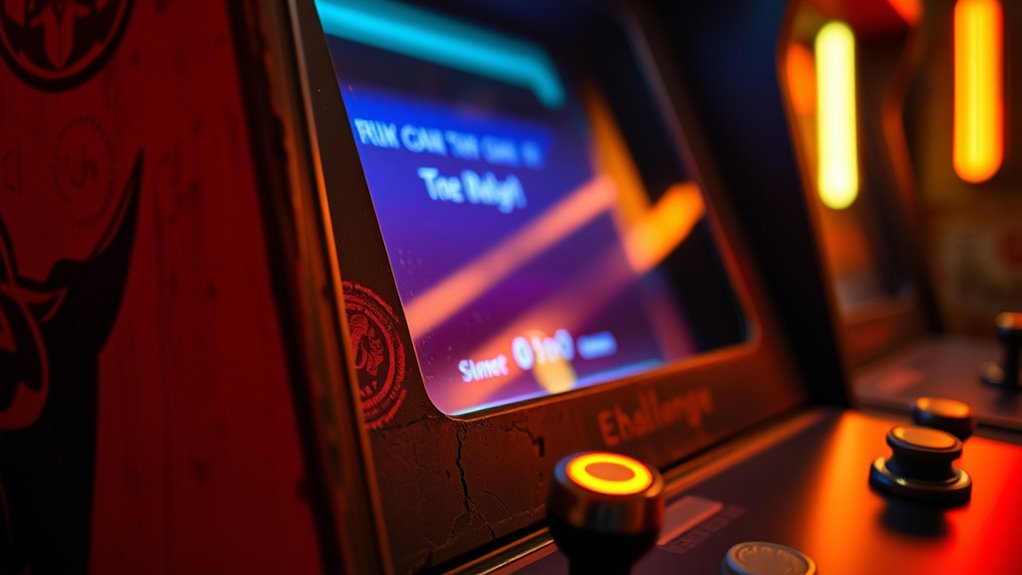
Challenging games naturally encourage players to return because they offer a sense of ongoing discovery and improvement. When difficulty scales appropriately, your motivation stays high, pushing you to master the game. This dynamic keeps gameplay fresh and engaging, making each session feel rewarding. Here are four ways challenge impacts replayability:
Challenging games motivate continuous play through discovery, skill growth, unpredictability, and rewarding persistence.
- Maintains player motivation through achievable yet tough goals.
- Promotes skill development, encouraging repeated attempts.
- Keeps gameplay unpredictable with difficulty scaling, preventing boredom.
- Rewards persistence, inspiring players to improve and beat their best scores.
- Incorporating secure payment processing ensures smooth transactions, which can enhance user trust and encourage continued engagement.
Designing for Skill Progression and Mastery
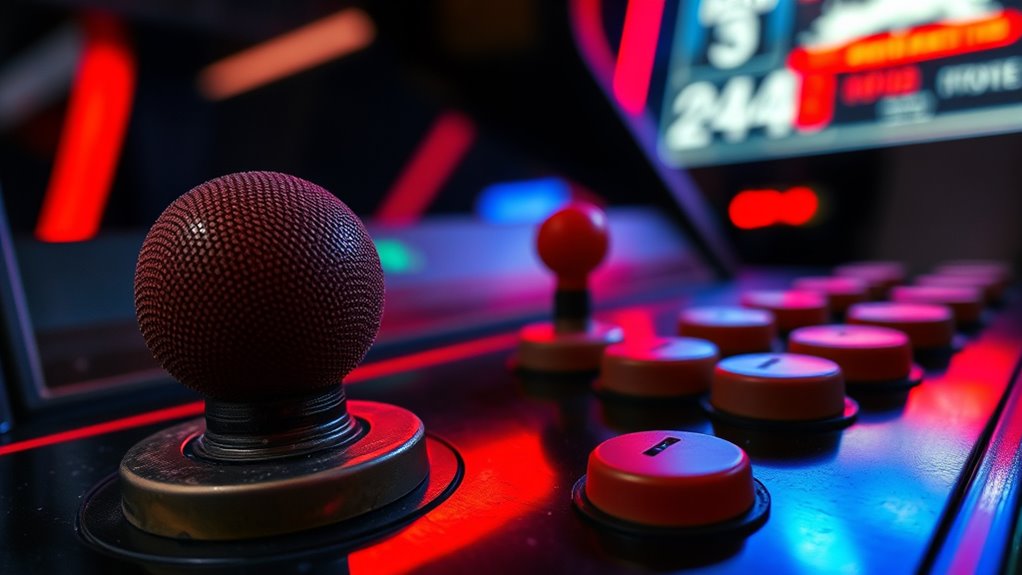
To foster skill progression and mastery in coin-op game design, you need to create a clear pathway for players to build on their abilities over time. Implementing procedural difficulty guarantees challenges scale naturally as players improve, preventing stagnation or frustration. By designing adaptive challenges, you can tailor the game experience to individual skill levels, encouraging continued engagement. This approach helps players feel a sense of accomplishment as they overcome progressively tougher obstacles, reinforcing their mastery. You should also introduce gradual complexity, allowing players to develop core skills before facing more demanding tasks. Combining procedural difficulty with adaptive challenges creates a dynamic environment where players are consistently pushed just beyond their comfort zone, fostering growth and long-term skill development. Additionally, incorporating dynamic communication exercises can enhance players’ understanding of game mechanics and improve their problem-solving abilities, further supporting skill mastery.
Revenue Implications of Game Difficulty

Although carefully calibrated difficulty can enhance player engagement, it also has significant implications for revenue generation. If a game is too easy, players may lose interest quickly, hurting player retention and reducing repeat earnings. Conversely, if it’s too hard, frustrated players might leave, impacting monetization strategies. To optimize revenue, consider these points:
- Balance difficulty to keep players motivated without overwhelming them.
- Use difficulty as a tool to encourage in-game purchases, like power-ups or hints.
- Adjust difficulty levels based on player skill to maximize engagement.
- Monitor how difficulty impacts the time spent playing and spending patterns.
- Incorporating contrast ratio considerations in game design can improve visual clarity, making gameplay more accessible and enjoyable for a wider audience.
Frequently Asked Questions
How Do Cultural Differences Influence Difficulty Settings in Coin-Op Games?
You recognize that cultural differences heavily influence difficulty settings in coin-op games. By implementing cultural adaptation, you guarantee games are engaging across diverse audiences. Difficulty calibration becomes essential, as what’s challenging in one culture may be easy in another. You adjust game parameters, balancing challenge and accessibility, so players worldwide enjoy a tailored experience. This approach boosts engagement, making your coin-op games appealing and culturally relevant everywhere.
What Psychological Factors Affect Players’ Perception of Game Difficulty?
You might not realize it, but your perception of game difficulty is influenced by psychological factors like player motivation and challenge perception. When you’re highly motivated, you tend to view difficult tasks as more rewarding, boosting your confidence. Conversely, if you see a challenge as overwhelming, you might feel discouraged. Your mindset, past experiences, and expectations shape how you interpret and respond to difficulty, directly impacting your overall gaming experience.
How Does Difficulty Impact Long-Term Brand Loyalty in Arcade Gaming?
Difficulty acts like a double-edged sword, shaping your long-term brand loyalty in arcade gaming. When you find the challenge just right, it boosts your engagement and keeps you coming back for more. Proper difficulty calibration guarantees players feel accomplished, fostering a connection with the game. If the game’s too hard or too easy, you might lose interest. Striking that balance is key to turning players into lifelong fans.
What Role Does Difficulty Play in Multiplayer Versus Single-Player Coin-Op Experiences?
You’ll find difficulty plays a key role in multiplayer versus single-player coin-op experiences by influencing difficulty scaling and player engagement. In multiplayer settings, adjusting difficulty keeps the game challenging for all players, encouraging teamwork and competition. For single-player games, difficulty levels offer tailored challenges that maintain engagement and prevent boredom. Both approaches guarantee players stay invested, making difficulty a crucial tool to enhance overall enjoyment and replayability across different gaming modes.
How Can Developers Predict Optimal Difficulty Levels for Diverse Player Demographics?
You can predict ideal difficulty levels by analyzing player engagement data and observing how players respond to challenges. Focus on skill calibration by adjusting game elements based on performance metrics, ensuring the game remains accessible yet engaging. Use player feedback and in-game analytics to identify patterns across diverse demographics, helping you tailor difficulty settings that keep players motivated and invested, regardless of their skill levels.
Conclusion
Ultimately, understanding how difficulty shapes your experience lets you craft games that keep players hooked, much like an arcade classic that never goes out of style. By balancing challenge and accessibility, you create a space where skill progression feels natural and mastery rewarding. Remember, just like a good mixtape, the right difficulty keeps players coming back for that satisfying sense of achievement—no need for a time machine, your game’s success is right in your hands.
